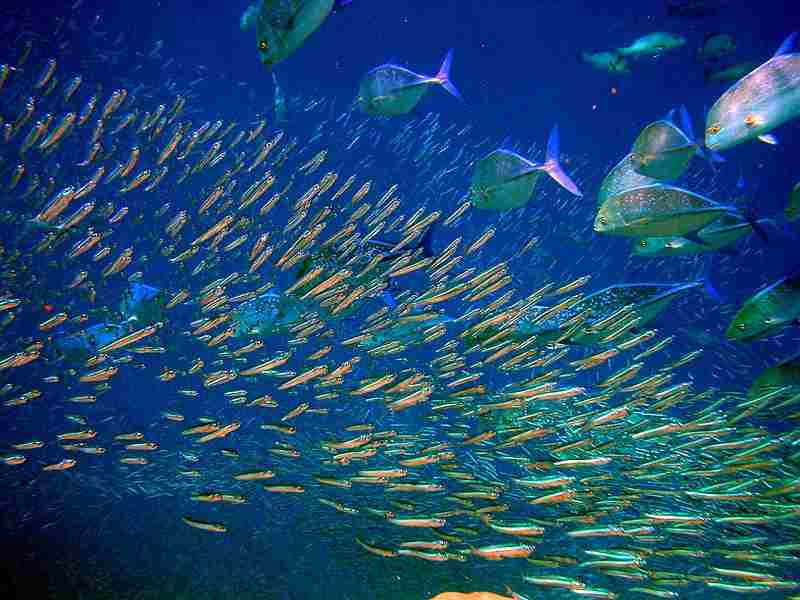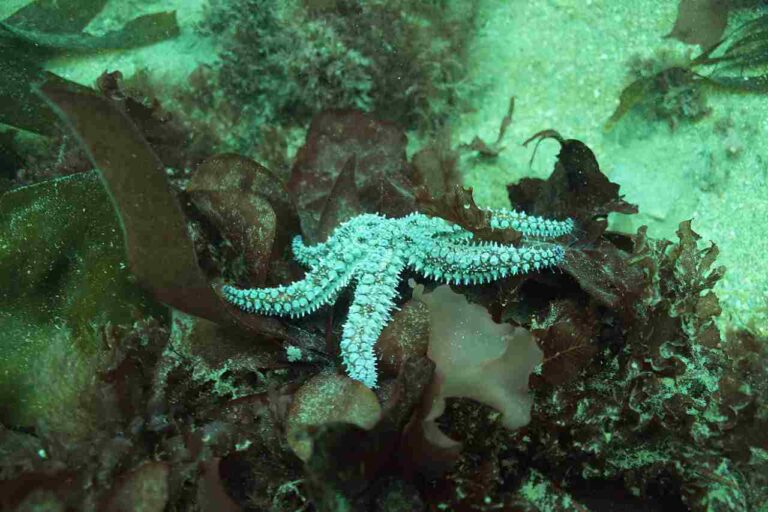5 Types of Biotic and Abiotic Factors in an Ecosystem
Types of biotic factors in an ecosystem are; producers (like algae and plants), consumers, and decomposers (like bacteria and fungi).
Types of abiotic factors in an ecosystem are; physical abiotic factors (like temperature, humidity, soil) and chemical abiotic factors (like pH and BOD).
This article discusses the types of biotic and abiotic factors, as follows;
-Types of Biotic Factors in an Ecosystem
Types of biotic factors are; producers (like vascular and non vascular plants), consumers, and decomposers.
*Producers
1). Vascular Plants
Vascular plants, as producers in an ecosystem, exhibit several basic characteristics, including the possession of conducting tissues, photosynthetic capability, cellulose cell walls, reproductive strategies, physiological variety, roots and leaves.
Vascular plants have specialized tissues (xylem and phloem) that transport water, nutrients, and sugars throughout the plant. This vascular system allows for efficient nutrient uptake and distribution.
Their autotrophic nature implies that vascular plants can produce their own food through photosynthesis. They use chlorophyll to convert light from the sun, carbon dioxide, and water into sugars and oxygen.
Vascular plants have cell walls made of cellulose, providing structural support to the plant and protecting it from physical stress.
They reproduce through the production of seeds (in seed plants) or spores (in non-seed plants), allowing them to disperse and establish new plants.
Vascular plants display a wide range of forms and adaptations, including trees, shrubs, herbs, and various growth patterns to suit different ecological niches.
Vascular plants typically have roots for anchorage and nutrient uptake and leaves for photosynthesis. These structures enable efficient resource acquisition.

Significant species richness and diversity are exhibited by vascular plants, with adaptations that allow them to thrive in various ecosystems, from deserts to rainforests and from high mountains to coastal plains.
Lastly, they form the foundation of the food chain, converting solar energy into organic biomass, which makes them primary producers and a fundamental component of energy transfer sequences, within both terrestrial and aquatic ecosystems.
2). Non Vascular Plants
Non-vascular plants, as producers in an ecosystem, possess basic characteristics like; absence of vascular tissues, relatively small size, water-dependency, spore-based reproduction, simple growth form, habitat preferences, multiple ecological roles, and primary succession.
Unlike vascular plants, non-vascular plants lack specialized tissues for water and nutrient transport, such as xylem and phloem.
Non-vascular plants are typically small in size compared to vascular plants, and have limited structural support, as they lack lignin-reinforced cell walls.
These plants are highly dependent on water for reproduction and nutrient uptake because they lack vascular systems. They are often found in damp, moist environments.
Non-vascular plants reproduce through spores rather than seeds. They release spores for dispersal and establishment of new individuals.
They have a simple growth form, with absence of true roots, stems, or leaves. Instead, they have structures like rhizoids for anchorage and water absorption.
Non-vascular plants tend to thrive most in wetlands, bogs, and other areas with high humidity, as they are adapted to water-retentive environments.
Although they have limited size and stature, non-vascular plants are important for soil stabilization, nutrient cycling, and contributing to overall ecosystem diversity.
They often play a role in the early stages of primary succession by colonizing bare, disturbed soils and preparing the ground for more complex plant communities.
Over time, non-vascular plants can help supply organic matter and improve soil structure, aiding in soil conservation and development.
Despite their small size and simplicity, non-vascular plants are vital components of ecosystems, particularly in environments where they are well-adapted to thrive.
3). Algae
Algae represent another example of producers, which are one of the types of biotic factors in ecosystems. They exhibit some basic characteristics like; photosynthetic capability, aquatic habitat preference, diversity, variability of morphology, ecosystem service rendering, and environmental sensitivity.
Algae are photosynthetic organisms that use chlorophyll to convert sunlight, carbon dioxide, and water into organic compounds, primarily sugars, and oxygen.
They are primarily aquatic, ranging from freshwater to marine environments, and are able to thrive in a wide range of water bodies, from ponds and lakes to oceans.
Algae encompass a diverse group of photosynthetic organisms, including microalgae (single-celled) and macroalgae (multicellular), such as seaweeds.
Algae exhibit a range of forms, from unicellular to complex multicellular structures, depending on their type and habitat.
They are primary producers in aquatic ecosystems, forming the foundation of the food chain/energy pyramid, by converting solar energy into organic matter.
Algae play a vital role in oxygen production, carbon cycling, and nutrient cycling in aquatic ecosystems, contributing to ecosystem health.
Many species of algae serve as a food source for various aquatic organisms, including zooplankton, small fish, and even larger marine animals.
Changes in algae populations can be indicative of unfavorable or abrupt environmental impacts/condition, which may affect water quality and nutrient levels.
Some species of algae are used by humans for food, such as nori in sushi, and for various industrial applications, including biofuel production and wastewater treatment.
Algae have significant ecological and environmental importance and contribute to the overall balance and sustainability of aquatic ecosystems.
4). Chemosynthetic Bacteria
Chemosynthetic bacteria, as producers in an ecosystem, possess basic attributes like; chemosynthetic capability, preference of abyssal marine habitat, symbiotic tendencies, and multiple ecological functions.
Unlike photosynthetic organisms, chemosynthetic bacteria utilize inorganic compounds, like hydrogen sulfide or methane, as a fundamental energy resource, to produce organic matter.
Chemosynthetic bacteria are often found in extreme environments, including deep-sea hydrothermal vents and cold seeps, where there is limited or no sunlight.
They are autotrophic, meaning they can synthesize their own organic compounds from inorganic sources without relying on external food.
Chemosynthetic bacteria form symbiotic relationships with various organisms, such as giant tube worms, and provide them with a source of nutrition.
In deep-sea ecosystems, chemosynthetic bacteria serve as the primary producers, providing the foundation for sustainable marine food webs that support a variety of specialized organisms.
These bacteria contribute to the biogenic diversity of deep-sea ecosystems by enabling the existence of unique, highly specialized organisms that have adapted to extreme conditions.
Chemosynthetic bacteria play a key role in nutrient cycling and energy flow within deep-sea ecosystems, enhancing overall ecosystem resilience.
Studying chemosynthetic bacteria and their ecosystems provides insights into extremophiles, the origin of life, and the potential for life in extreme environments beyond Earth.
Chemosynthetic bacteria often exist as part of complex microbial communities, interacting with other microorganisms in these extreme habitats.
Lastly, the discovery of chemosynthetic ecosystems has expanded our understanding of life on Earth and the potential for life in seemingly inhospitable environments.
*Consumers
1). Primary Consumers
Primary consumers in an ecosystem exhibit some typical characteristics, including herbivorous feeding behavior, relative biological simplicity, diverse diet, heterotrophic nature, variable size and mobility, and multiple ecological roles. These and more are outlined below;
Primary consumers are herbivores, primarily consuming plant material, such as leaves, fruits, and vegetation.
They occupy the first heterotrophic level (that is, the second trophic level) in a food chain or food web, feeding directly on primary producers (plants or algae).
Primary consumers obtain energy by converting the organic matter from primary producers into their own biomass.
While their main food source is plant material, primary consumers may also include some omnivores that consume both plants and other primary consumers (such as plant-eating mammals and insects that can feed on other consumers).
They are heterotrophic organisms, meaning they rely on external sources of food and cannot produce their own organic matter through photosynthesis or chemosynthesis.
Primary consumers vary in size, from small insects to large herbivorous mammals, and can be terrestrial or aquatic. Their mobility and foraging strategies depend on their size and environment.

Primary consumers often have predators in the secondary consumer category, which helps regulate their population size.
They serve as a vital link between primary producers and higher trophic levels, facilitating the flow of energy and nutrients through ecosystems.
The behavior and feeding habits of primary consumers can influence plant populations and plant community structure in an ecosystem.
Primary consumers constitute a key component of biodiversity, as different species have specific roles and interactions within ecosystems.
2). Secondary Consumers
Secondary consumers in an ecosystem exhibit some basic characteristics like carnivorous or omnivorous feeding behavior, predatory tendencies, morphological variability, and active contribution to ecological energy-transfer processes.
Secondary consumers are carnivores or omnivores, primarily feeding on primary consumers, other secondary consumers, or a combination of both.
They occupy the third trophic level in a food chain or web, feeding on primary consumers or other secondary consumers.
Secondary consumers exhibit predatory behavior, actively hunting or capturing their prey for food.
They obtain energy by consuming primary consumers or other organisms lower in the food chain, converting this energy into their own biomass.
Like primary consumers, secondary consumers are heterotrophic, meaning they rely on external sources of food.
Secondary consumers come in various sizes and may exhibit different hunting strategies and mobility based on their size and environment.
They often have predators in the tertiary consumer category, which help to regulate their population size.
Secondary consumers play a crucial role in controlling the population sizes of primary consumers and influencing the structure of lower trophic levels in ecosystems.
The diversity of secondary consumers is essential for maintaining ecological balance and biodiversity in ecosystems, as different species have specific roles and interactions within food webs.
Some secondary consumers may be considered top predators in ecosystems of territories, with few or no natural predators themselves, which can have cascading effects on lower trophic levels.
3). Tertiary Consumers
Attributes of tertiary consumers in an ecosystem include carnivorous feeding, active predatory behavior, heterotrophic nature, and multiple ecological functions.
Tertiary consumers are carnivores, primarily feeding on secondary consumers, other tertiary consumers, or a combination of both.
They occupy the fourth trophic level in a food chain or web, feeding on secondary consumers or other organisms lower in the food chain.
Tertiary consumers exhibit predatory behavior, actively hunting or capturing their prey for food.
They obtain energy by consuming organisms from lower trophic levels, converting this energy into their own biomass.
Tertiary consumers, like primary and secondary consumers, are heterotrophic, and rely solely on external sources of food.
Tertiary consumers come in various sizes and may exhibit different hunting strategies and mobility based on their size, adaptations and environment.
Tertiary consumers may have predators in the quaternary consumer category, helping regulate their population size.
Tertiary consumers play a key role in controlling the population sizes of secondary consumers and influencing the structure of lower trophic levels in ecosystems.
They are often considered top predators in an ecosystem, with few or no natural predators themselves, and their presence/activities can have cascading effects on lower trophic levels.
The diversity of tertiary consumers is important for maintaining ecological balance and biodiversity in ecosystems, as different species have specific roles and interactions within food webs.
4). Quaternary Consumers
Quaternary consumers in an ecosystem are distinguished by their characteristics, some of which are; carnivorous feeding, predatory behavior, variable morphology, and role in population regulation.
Quaternary consumers are carnivores, primarily feeding on tertiary consumers, other quaternary consumers, or a combination of both.
They occupy the fourth trophic level in a food chain or web, feeding on tertiary consumers or other organisms lower in the food chain.
Quaternary consumers exhibit predatory behavior, actively hunting or capturing their prey for food.
They obtain energy by consuming organisms from lower trophic levels, converting this energy into their own biomass.
Quaternary consumers, like primary, secondary, and tertiary consumers, are heterotrophic, relying on external sources of food.
Quaternary consumers come in various sizes and may exhibit different hunting strategies and mobility based on their size and environment. In marine ecosystems, they are usually several times larger than lower consumers; as is exemplified by whales.
While quaternary consumers may have fewer natural predators, they can still be regulated by factors such as food availability and interspecific competition.
Quaternary consumers play a crucial role in controlling the population sizes of tertiary consumers and influencing the structure of lower trophic levels in ecosystems.
They are often considered top predators in an ecosystem, with limited natural predators themselves, and their presence can have cascading effects on lower trophic levels.
The diversity of quaternary consumers contributes to maintaining ecological balance and biodiversity in ecosystems, as different species have specific roles and interactions within food webs.
*Decomposers
Decomposers in an ecosystem can be defined by their characteristics and functions, some of which are highlighted in the following outline;
Decomposers are heterotrophic organisms, which means that they rely on biomass from other organisms as their food source.
They include saprophytes and detritivores, which consume decaying organic material, such as dead plants, animals, and their waste products.
Decomposers are instrumental in breaking down complex organic compounds into simpler forms, thereby facilitating nutrient recycling.
By decomposing organic material, they release nutrients back into the ecosystem, making them available for use by primary producers.
Decomposers consist of various microorganisms, including bacteria and fungi, as well as macroscopic detritivores like earthworms and insects.

The biodegradation process involves the enzymatic breakdown of organic matter, leading to the release of carbon, nitrogen, and other essential elements.
Decomposers help to maintain ecosystem health and nutrient cycling, and contribute to overall ecosystem sustainability.
Their activity aids in the breakdown and recycling of waste materials, preventing the accumulation of organic matter in ecosystems.
Decomposers are an integral part of food webs, connecting the energy and nutrient flows between trophic levels.
Efficient decomposition is essential for maintaining ecosystem equilibrium and reducing the potential for disease spread from decaying matter.
-Types of Abiotic Factors in an Ecosystem
Types of abiotic factors in an ecosystem are; physical and chemical abiotic factors respectively.
*Physical Abiotic Factors
1). Temperature
Temperature, as one of the (physical) biotic factors in an ecosystem, serves some basic functions like the control of metabolic activities, species distribution, seasonal cycles, food web dynamics, aquatic ecosystem zonation, energy flow, weather trends; ecosystem resilience, and global climate.
Temperature affects the metabolic rates of organisms, with higher temperatures generally increasing metabolic activity and growth rates, while lower temperatures slow them down.
It is also an important factor in determining the geographic distribution of species, as different organisms have different temperature ranges within which they can thrive.
Temperature influences the activity of enzymes, with each organism having an optimal temperature range for enzyme function. Extreme temperatures can denature enzymes and disrupt physiological processes.
Seasonal temperature changes drive biological rhythms and life cycle events in many species, including breeding, migration, and hibernation.
Temperature affects the availability of prey and predators in food webs, thereby influencing predator-prey interactions and the overall biotic structure of entire ecosystems.
Temperature-based stratification in aquatic ecosystems, such as lakes, influences the distribution of nutrients and dissolved oxygen, and impacts the composition of aquatic communities.
The rate of photosynthesis and primary production by plants is affected by temperature, which in turn influences the energy flow through ecosystems.
Temperature is involved in shaping weather patterns and precipitation, impacting water availability and, consequently, ecosystem dynamics.
Organisms in an ecosystem may be adapted to a specific temperature range, making temperature changes a potential stressor that can affect ecosystem resilience and stability.
On a larger scale, temperature patterns influence climate zones and can contribute to climate change, which has widespread effects on ecosystems and biodiversity.
Generally, temperature is a fundamental abiotic factor that influences the physiology, behavior, and distribution of organisms, as well as the overall functioning and structure of ecosystems.
2). Humidity
Humidity, being one of the abiotic factors in an ecosystem, serves some important functions like the determination of water availability, desiccation rates, respiratory processes, microbial activities, plant transpiration, reproductive trends/strategies, organic migration, ecosystem zonation, microclimate formation, as well as instantaneous weather conditions.
Humidity is a measure of the amount of water vapor in the air. It influences water availability to both terrestrial and aquatic organisms, affecting their survival and hydration.
High humidity can help to prevent desiccation (drying out) of organisms, including within arid and intertidal environments, by reducing water loss through evaporation.
Humidity can impact the respiratory efficiency of many organisms. High humidity can make it easier for some terrestrial animals to breathe, while low humidity may increase water loss through respiration.
Microorganisms, including bacteria and fungi, are sensitive to humidity levels. It can influence their growth, activity, and decomposition processes in ecosystems.
Humidity affects the rate of transpiration in plants, influencing their water uptake and nutrient transport. It also influences leaf stomatal conductance and photosynthesis.
Humidity levels can trigger reproductive behaviors in some species, such as amphibians and certain insects, influencing breeding patterns.
Humidity can affect the migration patterns of birds and insects, as some species rely on specific humidity cues for navigation.
Humidity plays a role in defining ecological zones within ecosystems, such as the transition from terrestrial to aquatic habitats, as it affects the distribution of moisture and the organisms adapted to different humidity levels.
Humidity can contribute to the creation of microclimates within ecosystems, influencing the local distribution of species and plant communities.
Changes in humidity levels are associated with weather patterns, influencing precipitation, cloud formation, and weather events that can have cascading effects on ecosystems.
The points raised indicate that humidity is a critical abiotic factor that affects the hydration, behavior, and distribution of organisms in various ecosystems, with cascading effects on ecosystem processes and biodiversity.
3). Moisture Content
Moisture content is another example of physical abiotic factors in an ecosystem, and serves basic functions that include the control of water availability, plant growth, productivity, soil nutrient availability, habitat suitability, microbial activity, erosion control, temperature regulation, aquatic sustainability, microclimatic conditions, drought and flooding resilience.
Moisture content determines the amount of water in the soil, air, and other environmental components, thereby influencing water availability for both terrestrial and aquatic organisms.
Adequate moisture content is necessary for plant growth and productivity, and affects photosynthesis, nutrient uptake, and overall plant vitality.
Moisture content affects the solubility and availability of nutrients in the soil, including nutrient uptake by plants and the composition of soil microbial communities.
Also, moisture content influences the suitability of an ecosystem for various species. Some organisms, including amphibians, depend on specific moisture levels for survival and reproduction.
Soil moisture content influences the activity of soil microorganisms involved in biodegradation and nutrient cycling processes.
Adequate soil moisture often helps to mitigate soil erosion and loss of topsoil, preserving soil structure and fertility.
Moist soil retains heat more effectively than dry soil, contributing to temperature regulation within the soil and influencing the thermal environment for soil-dwelling organisms.
Moisture content in aquatic ecosystems can affect water levels, influencing the availability of habitat for aquatic organisms and the extent of wetland areas.
Differences in moisture content contribute to the formation and delineation of microclimates within ecosystems, influencing the local distribution of species and ecological processes.
Variability in moisture content can also influence the resilience of ecosystems to droughts and floods, and the ability of species to cope with extreme conditions.
4). Turbidity
Turbidity, as an abiotic factors in ecosystems, is also a contributor to phenomena like water clarity, light availability, temperature regulation, sediment transport, nutrient transport, habitat suitability, fish behavior, erosion indication, primary producer competition, and water quality conditions.
Turbidity measures the cloudiness or haziness of water. It affects water clarity by scattering and absorbing light, influencing the depth to which light can penetrate in aquatic ecosystems.
Turbidity impacts the availability of light for photosynthesis in aquatic plants and algae. High turbidity can limit light penetration, affecting primary productivity.
Turbidity can alter water temperature by influencing the absorption of solar radiation. It may help to moderate temperature fluctuations in some aquatic environments.
High turbidity often indicates the presence of suspended sediments and other kinds of particulate matter in the water. Turbidity plays a role in sediment transport and deposition within aquatic ecosystems.
Particulate matter in turbid water can carry nutrients and organic material, affecting nutrient dynamics within aquatic systems and influencing the nutrient availability to aquatic organisms.
Turbidity can affect the suitability of aquatic habitats for various species. Some organisms are adapted to specific turbidity levels, while others may be sensitive to changes in water clarity.
Turbidity can influence the behavior and feeding patterns of fish. Some fish species use turbid water as cover from predators, while others may rely on visual cues to locate both food and suitable refuge.

High turbidity can be an indicator of localized soil erosion and other environmental issues in the watershed, providing insights into land use impacts on aquatic ecosystems.
Turbidity can alter competition among primary producers, as it affects light availability for photosynthesis. Algae and submerged plants may respond differently to changes in turbidity.
Monitoring turbidity is a valuable tool for assessing water quality and the impact of human activities on aquatic ecosystems, aiding in conservation and management efforts.
The concepts discussed show that turbidity is an important abiotic factor that influences water clarity, light availability, and various ecological processes in aquatic ecosystems. It is instrumental in temperature regulation, sediment transport, and nutrient cycling, and affects the overall wellbeing and diversity of aquatic environments.
5). Light Availability
Light availability is another important abiotic factors in an ecosystem. It is instrumental toward photosynthesis, primary production, food web energy dynamics, plant growth and biomass, organic diversity, habitat suitability, circadian rhythms, water temperature, energy flow, and environmental monitoring.
Light availability is essential for photosynthesis in plants and algae, as it determines the provision of energy needed to convert carbon dioxide and water into organic compounds. This process forms the basis of primary production in ecosystems.
Also, light availability directly influences the rate of primary productivity, determining the amount of organic matter that can be synthesized by autotrophic organisms, such as plants.
Primary producers, fueled by light availability, serve as the primary bioenergy source for higher trophic levels in food webs, including herbivores, carnivores, and decomposers.
Adequate light availability is important for plant growth and the accumulation of biomass, as it influences the structure and composition of plant communities in both terrestrial and aquatic ecosystems.
Light availability affects the composition of species in an ecosystem, as different species have varying light requirements. It plays a role in determining which species can thrive in a given environment.
Light availability defines the suitability of habitats for various organisms. Shade-tolerant species can thrive in low-light environments, while light-demanding species require higher light levels.
Daily and seasonal biological rhythms are regulated mostly by the availability of light; and influences behaviors such as feeding, breeding, and migration in many organisms.
Light can influence water temperature, as it is absorbed by water and converted into heat. Light availability can thus affect thermal conditions in aquatic ecosystems.
The availability of light energy affects the overall flow of energy resources through ecosystems, shaping trophic relationships and influencing population dynamics and community structure.
Lastly, light availability is used as an indicator of environmental conditions and can be monitored to assess the impact of changes, such as deforestation or water quality alteration, on ecosystems.
6). Rocks
Rocks in an ecosystem, are abiotic components that serve basic functions like the provision of suitable substrate for organisms, erosion control, aquatic habitat diversification, thermal regulation, water filtration, nutrient sequestration/release, geomorphology determination, and provision of mineral resources. More details are provided in the outline below;
Rocks provide a substrate for the attachment and growth of various organisms, including algae, lichens, and mosses, contributing to the formation of microhabitats.
Rocks can help stabilize soil and prevent erosion in terrestrial ecosystems, reducing the loss of fertile topsoil and maintaining landscape integrity.
In aquatic ecosystems, rocks create diverse habitats, such as rocky shores and streambeds, supporting the attachment of algae and serving as shelter for aquatic organisms.
Rocks can absorb and radiate heat, influencing the temperature of the surrounding environment. They play a role in creating microclimates for thermoregulation by some organisms.
Porous rocks can act as natural filters, purifying groundwater and improving water quality by removing impurities and contaminants.
Essential nutrients can be released from rocks through weathering, including elements like calcium and magnesium. These nutrients enter the surrounding environment, where they benefit plant growth and ecosystem nutrient cycling.
Rocks shape the physical features of an ecosystem, contributing to the creation of landforms, canyons, cliffs, and geological structures that influence habitat diversity.
Rocks are a source of valuable minerals and resources used by humans, such as construction materials, gemstones, and minerals for industrial processes.
Different types of rocks, such as limestone, sandstone, and granite, may support unique microecosystems due to their varying chemical compositions and physical characteristics.
Rocks contain information about the geological history of an area, including clues about past climate conditions, tectonic movements, and the evolution of landscapes.
Generally, rocks play a multifaceted role in ecosystems, as they contribute to habitat diversity, erosion control, and the well-being of both terrestrial and aquatic organisms. They also have ecological, geological, and cultural significance in various contexts.
7). Soil
Soil, as one of the abiotic factors in an ecosystem, serves some basic functions including nutrient storage and cycling, facilitation of plant growth, habitat provision for microorganisms, water filtration, carbon sequestration, and microclimate formation,. They also have anthropogenic value, which is mentioned in the outline below;
Soil stores essential nutrients, such as nitrogen, phosphorus, and potassium, and facilitates their cycling within the ecosystem. This supports plant growth and nutrient availability for organisms.
Also, soil provides a viable medium for plant growth, offering physical support, anchorage, and a reservoir of water and nutrients necessary for plant development.
Soil hosts a diverse community of microorganisms, including bacteria, fungi, and invertebrates, which play critical roles in decomposition, nutrient recycling, and organic matter decomposition.
In some ecosystems, soil acts as an efficient natural filter, purifying water as it percolates through the layers, removing contaminants and impurities, and replenishing groundwater.
Vegetation that is anchored in soil helps mitigate erosion, reducing the loss of fertile topsoil and maintaining landscape stability.
Soil is also an effective carbon sink, which stored organic carbon from decomposed plant and animal matter. This contributes to carbon sequestration and helps mitigate climate change.
Characteristics of soil, such as color, texture, and moisture content, influence local geography and microclimates, affecting temperature, humidity, and soil-dwelling organisms.
Soil properties like pH and nutrient availability, determine which plant species can thrive in a particular area, shaping the composition of plant communities.
For numerous burrowing organisms, including earthworms, ants, and small mammals, soil serves as a reliable habitat. The activities of these organisms in turn influences soil structure and aeration.
Soil layers can preserve archaeological and historical artifacts, offering insights into past human activities, land use, and cultural heritage.
As implied above, soil plays a pivotal role in ecosystem functioning by supporting plant growth, nutrient cycling, and the habitat for a diverse range of organisms. It also contributes to water purification, erosion control, and the storage of essential nutrients and carbon.
*Chemical Abiotic Factors
1). Oxygen Availability
Oxygen availability is a chemical abiotic factor in ecosystems, which serves multiple functions including the facilitation of organic respiration, aerobic decomposition, aquatic ecosystem sustenance, redox reactions, and the alteration of nutrient cycling trends, water quality, resilience to hypoxia, energy transfer, and microbial dynamics.
Oxygen is essential for the respiration of aerobic organisms, including most animals and many microorganisms. It provides the energy needed for metabolic processes.
Also, oxygen supports the decomposition of organic matter by aerobic bacteria and fungi, breaking down detritus and organic materials.
In aquatic ecosystems, dissolved oxygen is critical for the survival of aquatic organisms. It is necessary for fish and other aquatic species to respire.
The availability of oxygen influences redox (reduction-oxidation) reactions in soil and sediments, thereby affecting the chemical transformations of nutrients and minerals.
Oxygen cycles affect other nutrient cycling processes, such as nitrogen and sulfur cycling, by affecting the activity of microorganisms involved in these processes.
Oxygen availability defines the suitability of habitats for various organisms, as some species are adapted to thrive in well-oxygenated environments, while others can tolerate lower oxygen levels.
Monitoring oxygen levels is crucial for assessing water quality in aquatic ecosystems, as low dissolved oxygen can indicate pollution or environmental stress.
High oxygen levels can enhance the resilience of ecosystems to occasional hypoxia (low oxygen conditions), thereby sustaining a diversity of species.
Oxygen availability is central to energy transfer and trophic interactions within ecosystems, as it affects predator-prey relationships and the flow of energy through food webs.
Lastly, oxygen influences the composition and activity of microbial communities, shaping nutrient cycling and decomposition rates in ecosystems.
The discussion so far implies that oxygen availability is fundamental in supporting respiration, nutrient cycling, and the survival of aerobic organisms. It also affects the redox chemistry of ecosystems, impacting chemical reactions and biological processes.
2). pH
Some functions and influences that can be attributed to pH in an ecosystem, include; nutrient dynamics control, toxicity regulation, microbial activity, aquatic organism survival, habitat suitability determination, water quality, corrosion prevention, and carbonate equilibrium.
pH influences the availability and solubility of essential nutrients, such as nitrogen, phosphorus, and micronutrients, which impact plant growth and ecosystem productivity.
pH can affect the dynamics of various elements and compounds in the environment. It can influence the bioavailability and potential harm of substances like heavy metals.
Levels of pH levels influence the activity and diversity of microorganisms in soils and aquatic ecosystems, which, in turn, impact nutrient cycling and decomposition processes.
Also, pH affects chemical reactions in the environment, including the breakdown of organic matter, precipitation of minerals, and redox reactions that influence nutrient cycling.
In aquatic ecosystems, pH is crucial for the survival of aquatic organisms. Many species have specific pH tolerance ranges, and fluctuations outside these ranges can be detrimental.
pH defines the suitability of habitats for different organisms. Some species are adapted to specific pH conditions, influencing community composition.
Monitoring pH is important for assessing water quality, as deviations from natural pH levels can indicate pollution or environmental disturbances.
In aquatic systems, pH can impact the corrosion of infrastructure, such as pipes and equipment, which has economic and environmental implications.
Lastly, pH is linked to the carbonate equilibrium, which affects the availability of carbonate ions in aquatic ecosystems and is important for organisms that build shells and skeletons.
3). Biochemical Oxygen Demand (BOD)
Biochemical Oxygen Demand (BOD), is another chemical abiotic factor in an ecosystem, which is relevant within various contexts that include; water quality condition, organic matter decomposition, oxygen depletion, eutrophication, wastewater treatment, and overall environmental health.
BOD is often a reliable indicator of water quality. It measures the amount of oxygen consumed by microorganisms while breaking down organic matter in water. High BOD levels may indicate severe water pollution or the presence of organic contaminants.
Also, BOD reflects the rate at which organic substances, such as sewage, plant material, or pollutants, are broken down by microorganisms in aquatic ecosystems. This decomposition process influences water clarity and oxygen levels.
BOD directly impacts dissolved oxygen levels in aquatic systems. Elevated BOD can lead to a decrease in dissolved oxygen, potentially causing hypoxia or anoxic conditions harmful to aquatic life.
BOD is used to assess the potential for eutrophication, a process where excess nutrients lead to algal blooms, oxygen depletion, and ecological imbalances in aquatic ecosystems.
In wastewater treatment processes, BOD is a critical parameter. It helps monitor the effectiveness of treatment facilities in removing organic pollutants and improving effluent water quality.

BOD measurements are used to ensure that discharges into water bodies meet regulatory standards for water quality and environmental protection.
Monitoring BOD levels helps protect aquatic ecosystems, as excessive organic pollution can harm aquatic organisms and disrupt ecosystem dynamics.
Generally, Biochemical Oxygen Demand is a key parameter for assessing water quality, understanding the decomposition of organic matter, and managing the health of aquatic ecosystems. It plays a vital role in environmental monitoring and pollution control efforts.
Conclusion
Types of biotic factors in an ecosystem are;
Producers
Consumers
Decomposers
Types of abiotic factors in an ecosystem are;
Physical Abiotic Factors
Chemical Abiotic Factors










